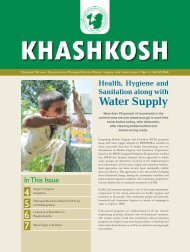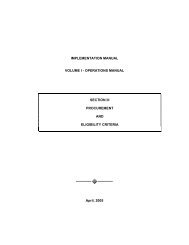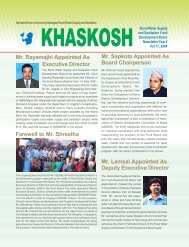ANNUAL REPORT_2008.pdf - Rural Water Supply and Sanitation ...
ANNUAL REPORT_2008.pdf - Rural Water Supply and Sanitation ...
ANNUAL REPORT_2008.pdf - Rural Water Supply and Sanitation ...
You also want an ePaper? Increase the reach of your titles
YUMPU automatically turns print PDFs into web optimized ePapers that Google loves.
testing <strong>and</strong> mitigation, (vi) arsenic removal,<br />
(vii) environmental quality control, <strong>and</strong> (viii)<br />
environmental management action plan.<br />
The Board is practicing social appraisal for<br />
scheme-level monitoring on top of its regular<br />
third party monitoring through Social Audit<br />
Committees. The Board also pilots social<br />
accountability using community score cards<br />
to more efficiently ensure transparency <strong>and</strong><br />
accountability. This would help to learn from<br />
the field experiences for improving<br />
governance <strong>and</strong> social accountability aspects<br />
throughout the scheme cycle. The process<br />
will not only facilitate the implementation of<br />
drinking water supply schemes but where<br />
all levels of service delivery <strong>and</strong> development<br />
activities are at the community level ensure<br />
that it happens in a transparent <strong>and</strong><br />
accountable manner. A survey of 820<br />
schemes out of the total 1314 schemes that<br />
were completed between August 1999 <strong>and</strong><br />
July 2008 found that at least 82 percent of the<br />
communities had maintained their accounts<br />
in a satisfactory manner. The same survey,<br />
which was conducted in Dec 2008, also found<br />
that 83 percent of the schemes had displayed<br />
the records publicly on display boards.<br />
Governance reforms in Nepal have been<br />
considered essential for sectoral interventions<br />
supported by the World Bank. The<br />
Government’s efforts towards reforms<br />
include enactment of the new Anti-<br />
Corruption Act in 2002, enactment of the<br />
Public Procurement Act in 2007 <strong>and</strong> Right to<br />
Information Act in 2007. The Board has been<br />
supporting the Government’s reform efforts,<br />
including its enactment of the new Anti-<br />
Corruption Act in 2002, the Public<br />
Procurement Act in 2007 <strong>and</strong> the Right to<br />
Information (RTI) Act in 2007.<br />
Monitoring<br />
<strong>and</strong> Evaluation<br />
A<br />
broader <strong>and</strong> yet comprehensive M&E system is applied<br />
by the Board with four elements or types of monitoring<br />
Lsegments – community monitoring, compliance <strong>and</strong><br />
process monitoring, outcome <strong>and</strong> impact monitoring,<br />
<strong>and</strong> strategic monitoring. The community monitoring includes the<br />
perceptions of the community/users/WUSC of the services <strong>and</strong> facilities<br />
provided including the self-situation analysis. This will focus on users’<br />
capacity to manage the assets <strong>and</strong> awareness generated by participation<br />
in the Board program. Support organizations facilitate its respective<br />
communities to do the assessment. Compliance monitoring focuses on<br />
physical, financial <strong>and</strong> logistic aspects of projects, while process<br />
monitoring deals with critical processes which are directly related to the<br />
project’s objectives. The process monitoring examines the suitability<br />
<strong>and</strong> effectiveness of community processes such as social mobilization,<br />
project implementation methodology such as community selection<br />
criteria <strong>and</strong> the impact of the project on capacity-building of<br />
communities. The outcome <strong>and</strong> impact monitoring attempts to assess<br />
the changes generated by the activities, inputs, <strong>and</strong> services in terms of<br />
the long-term objectives of the Board focusing primarily on the key<br />
development impact indicators as described earlier. The strategic<br />
monitoring is geared to documenting, disseminating, <strong>and</strong> learning from<br />
experience specifically focusing on key subject matter of importance.<br />
The Board’s adaptive <strong>and</strong> programmatic approach requires feedback<br />
on which approaches are working well <strong>and</strong> which are not.<br />
The Board <strong>and</strong> its partner organizations, the community, SO <strong>and</strong> SA<br />
<strong>and</strong> the local authority (DDC/VDC) all are involved in monitoring <strong>and</strong><br />
evaluation systems of program activities. All the data <strong>and</strong> information<br />
received from partner organizations in well developed formats are<br />
computerized <strong>and</strong> stored in the Board’s Management Information<br />
System (MIS) since RWSSP-I.<br />
Gradual improvements are being taken place in this system in RWSSP-<br />
II to support management to manage project related information <strong>and</strong><br />
facilitate for efficient monitoring <strong>and</strong> evaluation. Apart from Project<br />
Management Information System (PMIS), which is in practice from<br />
RWSSP-I, Technical Management Information System (TMIS) <strong>and</strong><br />
Financial Management Information System (FMIS) are in practice in<br />
RWSSP-II. At present, the MIS Unit has been facilitating the Board staff<br />
for IT Logistic/Equipments, bridging information in network, managing<br />
web site, considering/implementing safe guard for data security <strong>and</strong><br />
virus threat issues. In addition, this unit has deployed automated backup<br />
system for data protection at client side, while the three server that<br />
control complete network system has been mirrored to stay secure<br />
with last minute updated data.<br />
Having realized some technical problems in the existing MIS system<br />
<strong>and</strong> to make it more users’ friendly <strong>and</strong> informative, the Board finally<br />
agreed to go in Web-Centric technology so that it is accessible from the<br />
internet which also includes the migration of TMIS <strong>and</strong> FMIS on similar<br />
technology. Web-Centric MIS System is developed in year 2008 <strong>and</strong> it is<br />
installed for experiment in some of the computers of the Board. This<br />
new system will be operationalized by early 2009.<br />
24 · RWSSFDB Annual Report 2008



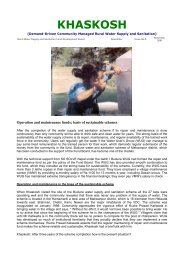
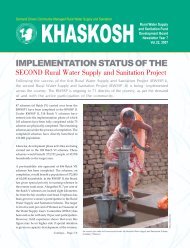
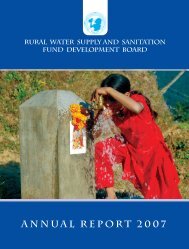
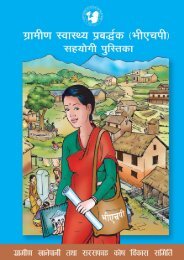


![vfg]k fgL tyf ;/;kmfOsf] If]qdf sf]if ljsf; ;ldltsf] cjwf/0ff pTs[i7 cEof](https://img.yumpu.com/38832733/1/190x245/vfgk-fgl-tyf-kmfosf-ifqdf-sfif-ljsf-ldltsf-cjwf-0ff-ptsi7-ceof.jpg?quality=85)

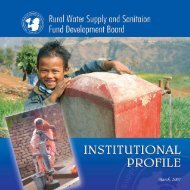
![Request for Proposals RFP # [162] - Rural Water Supply and ...](https://img.yumpu.com/38832347/1/184x260/request-for-proposals-rfp-162-rural-water-supply-and-.jpg?quality=85)
